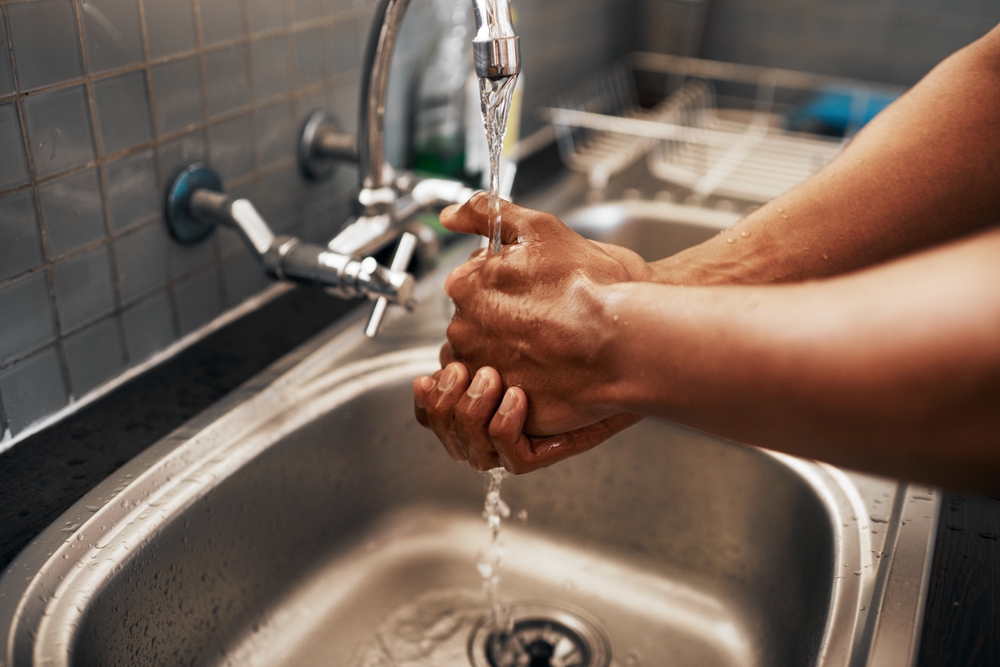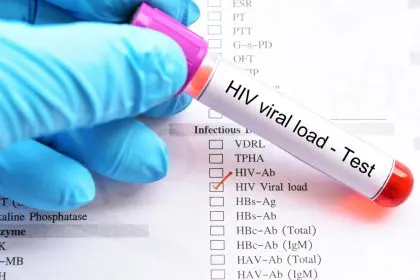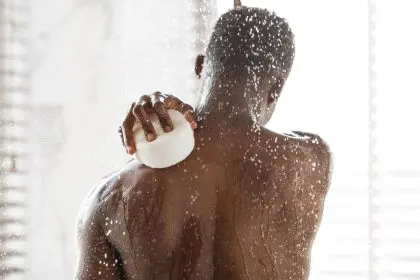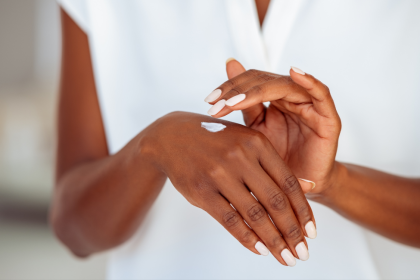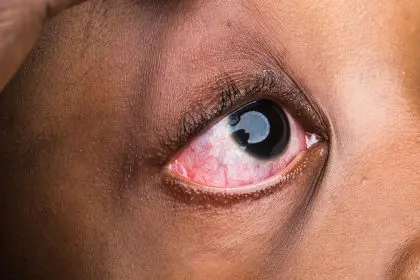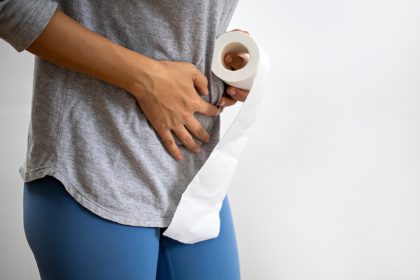We all know the basics of staying clean. Shower regularly. Brush your teeth. Wash your hands after using the bathroom. But beyond these fundamental habits lies a whole universe of less-discussed hygiene practices that significantly impact your health in ways most people never realize.
These unspoken hygiene habits rarely make it into childhood lessons or doctor’s visits, yet they influence everything from your immune function to your mood to your long-term disease risk. Some seem trivial at first glance but create cascading health effects when neglected.
Let’s pull back the shower curtain on these overlooked cleanliness practices that might be silently undermining your wellbeing.
Your shower routine is probably growing invisible biofilms
You diligently clean your body in the shower, but when was the last time you cleaned the shower itself? That showerhead you stand under every morning could be spraying you with more than just water.
Showerheads develop biofilms—complex communities of bacteria, fungi, and amoebas—that thrive in the warm, moist environment. When water passes through these biofilms, it can aerosolize these microorganisms directly into your airways.
Research has found that shower biofilms frequently harbor Mycobacterium species related to lung infections, particularly in people with compromised immune systems. Even in healthy individuals, regular exposure to these microbial aerosols can trigger inflammatory responses you might misattribute to allergies or stress.
The solution isn’t complicated, but it is often overlooked. Removing and soaking showerheads in vinegar monthly dissolves mineral buildup and disrupts biofilm formation. For fixed showerheads, tie a plastic bag filled with vinegar around the showerhead overnight. This simple habit significantly reduces your exposure to potentially harmful microbes during your daily cleansing ritual.
The toothbrush storage mistake almost everyone makes
Your oral hygiene routine might be impeccable, but where you store your toothbrush could be sabotaging your efforts. That convenient toothbrush holder on your bathroom counter? It’s likely collecting airborne particles from an unsavory source.
When you flush a toilet with the lid up, microscopic water droplets containing whatever was in the bowl are propelled up to six feet into the surrounding air. This phenomenon, aptly called “toilet plume,” deposits particles on nearby surfaces—including your exposed toothbrush.
Studies have found fecal bacteria on toothbrushes stored in bathrooms, regardless of how clean the bathroom appears. Each time you brush your teeth with a contaminated brush, you’re reintroducing these microbes directly into your mouth and potentially your respiratory and digestive systems.
The fix is straightforward: Store toothbrushes inside a cabinet or drawer, and always close the toilet lid before flushing. For added protection, consider a UV toothbrush sanitizer, which uses ultraviolet light to kill lingering bacteria between uses.
The hidden mold farm in your coffee maker
That morning cup of coffee might be delivering more than caffeine. The warm, damp interior of coffee makers—especially single-serve pod machines with water reservoirs—creates ideal conditions for mold and bacterial growth.
A study by the National Sanitation Foundation found that coffee maker reservoirs rank as the fifth most germ-laden place in typical homes, with some harboring higher bacteria counts than bathroom door handles. These microorganisms aren’t just hanging out harmlessly—they’re being incorporated into your daily brew.
For people with mold sensitivities or compromised immune systems, this unchecked growth can trigger chronic inflammation, persistent congestion, headaches, and fatigue that seem to have no obvious cause.
Descaling your coffee maker with vinegar or manufacturer-recommended solutions isn’t just about preventing mineral buildup—it’s a crucial hygienic practice. Empty and dry the water reservoir between uses, and run cleaning cycles weekly. Your morning brew should wake you up, not compromise your immune system.
Your belly button might be harboring a bacterial jungle
When was the last time you deliberately cleaned your navel? If you’re struggling to remember, you’re not alone. This tiny body crevice is among the most neglected hygiene areas, yet its unique environment makes it particularly problematic when overlooked.
The belly button creates a perfect microbial habitat—warm, moist, protected, and rarely disturbed. Research from the Belly Button Biodiversity Project found an average of 67 different bacterial species in participants’ navels, with some harboring over 100 distinct types. Many of these were species typically found in soil or on skin, but others were more exotic and potentially concerning.
While most of these microbes are harmless in small numbers, an uncleaned navel can develop unpleasant odors from bacterial breakdown products and potentially lead to infections, particularly for people with deep umbilical folds.
The solution is simple: Use a cotton swab lightly moistened with gentle soap during showers to clean this often-forgotten body part. For deeper navels, a diluted alcohol solution can help reduce excessive bacterial colonization without irritating the sensitive skin.
Your cell phone is probably filthier than a toilet seat
We check our phones 96 times per day on average—that’s once every 10 minutes. Yet most people clean their phones less than once a month, if ever. The result? A portable petri dish that you regularly press against your face.
Multiple studies have found that the average cell phone carries more bacteria than a public toilet seat, including potential pathogens like E. coli, Staphylococcus aureus, and various fungi. These microbes transfer to your hands, face, and any food you eat while using your phone.
This constant microbial exposure creates a low-grade challenge to your immune system that can manifest as unexplained skin breakouts along your jawline, frequent minor respiratory infections, or generalized fatigue as your body continuously responds to these invisible invaders.
Cleaning your phone doesn’t require special equipment—a microfiber cloth slightly dampened with 70% isopropyl alcohol effectively removes most contaminants without damaging electronics. Aim for daily quick wipes and a more thorough cleaning weekly, especially if you use your phone during meals or in high-contamination environments like bathrooms or public transportation.
The pillowcase problem that’s affecting your skin and lungs
You spend approximately a third of your life with your face pressed against your pillow, yet changing pillowcases often falls low on the hygiene priority list. This oversight creates significant consequences for both skin and respiratory health.
During sleep, your pillowcase collects dead skin cells, hair oils, saliva, sweat, and any products in your hair or on your face. This accumulation creates an ideal environment for dust mites—microscopic arachnids that feed on these human remnants and produce waste that ranks among the most common allergens worldwide.
Beyond allergies, pillowcase buildup contributes to acne, as bacteria feeding on this organic matter transfer back to your skin during sleep. For people with respiratory sensitivities, breathing dust mite allergens throughout the night can trigger morning congestion, throat irritation, and worsened asthma symptoms.
Changing pillowcases twice weekly significantly reduces these exposures. For enhanced protection, consider allergen-proof covers that create a barrier between you and the pillow itself, which can harbor even more allergens in its deeper layers.
The hidden hygiene risk of reusable water bottles
Carrying a reusable water bottle is environmentally responsible and helps ensure proper hydration. However, these well-intentioned vessels often become unintentional science experiments when cleaning routines fall short.
The narrow openings, threaded caps, and sometimes complicated straws or spouts of reusable bottles create challenging-to-clean spaces where biofilms readily develop. Studies examining used water bottles have found that many contain bacterial concentrations comparable to licking a dog’s toy or your household drain.
While most people with healthy immune systems won’t develop serious illness from a dirty water bottle, the constant exposure to these microbes can contribute to unexplained digestive disturbances, recurrent mild throat irritation, or mouth sores that seem to appear without obvious cause.
The proper cleaning protocol involves daily washing with hot, soapy water—including complete disassembly of all parts—and weekly deep cleaning with either a bottle brush and vinegar solution or the dishwasher if the bottle is dishwasher-safe. Bottles should dry completely between uses, as moisture encourages continued microbial growth.
The bathtub ring that’s more than just unsightly
That subtle ring that forms in your bathtub isn’t just a cleaning oversight—it’s a biofilm containing a complex mixture of body oils, dead skin, product residue, and the microorganisms feeding on this organic matter.
When you sit in a bathtub with an established biofilm, your skin absorbs whatever compounds these microbes are producing. For people with sensitive skin, this exposure can trigger unexplained rashes, folliculitis, or generalized irritation that appears mysterious because it develops hours after bathing.
More concerning is the potential for these biofilms to harbor opportunistic pathogens like Pseudomonas aeruginosa, which can cause external ear infections, hot tub folliculitis, or even wound infections if you have any skin breaks while bathing.
Regular scrubbing with baking soda paste or vinegar solutions disrupts these biofilms before they become established. For extra protection, wiping down bath surfaces after use removes the organic matter these microorganisms need to thrive.
The laundry mistake that leaves your clean clothes anything but
You diligently wash your clothes, but if you’re leaving wet laundry in the machine for hours before transferring it to the dryer, you’re creating perfect conditions for microbial growth. That mildew smell isn’t just unpleasant—it indicates active fungal colonies on the fabrics touching your skin all day.
Research shows that these fungi produce compounds called mycotoxins that can trigger inflammatory responses when in prolonged contact with skin. For sensitive individuals, this exposure manifests as unexplained skin irritation, respiratory symptoms, or heightened allergic responses that seem disconnected from their source.
The solution is straightforward: Transfer clothes to the dryer immediately after washing. If delays are unavoidable, running a quick rinse cycle before drying helps remove microbes that have multiplied during the wait. For clothes that remain malodorous despite washing, adding a cup of vinegar to the rinse cycle helps kill lingering fungi and bacteria without damaging fabrics.
Your kitchen sponge is the bacterial equivalent of a megacity
That innocent-looking kitchen sponge harbors more microbial life than almost any other household item—with bacterial densities comparable to a human stool sample. Each cubic inch can contain up to 54 billion bacterial cells representing hundreds of different species.
The porous structure, constant moisture, and food particles create ideal conditions for explosive bacterial growth. More concerning is that regular cleaning methods often make the situation worse—gentle dish soap removes food particles but leaves the hardiest bacteria behind to reproduce without competition.
This microbial reservoir spreads across every surface you wipe, potentially including cutting boards and dishes that directly contact food. For people experiencing unexplained gastrointestinal disturbances, the humble kitchen sponge often deserves investigation.
Microwaving damp sponges for two minutes or running them through the dishwasher with a heated dry cycle effectively reduces bacterial loads temporarily. However, replacing sponges weekly provides the only reliable solution, as even sanitized sponges quickly recolonize due to their ideal growth structure.
The missing hygiene habit that impacts your entire home
One of the most overlooked hygiene practices happens at your doorway: removing outdoor shoes before entering your home. This simple habit dramatically reduces the introduction of harmful substances into your living environment.
Shoe soles transfer not just visible dirt but an invisible toxic load including:
- Pesticides and herbicides from treated lawns and public spaces
- Industrial pollutants from roadways and parking lots
- Bacterial contamination including E. coli from contact with public restroom floors
- Heavy metals from soil near roadways or industrial areas
- Allergens like pollen and mold spores that become airborne when disturbed
These substances don’t stay on your floors—they become airborne particulates when disturbed by movement, eventually settling on food preparation surfaces and being inhaled by all household members.
Studies comparing homes with and without no-shoes policies find significantly reduced indoor contamination in shoeless households. This reduced toxic load correlates with fewer respiratory symptoms, lower allergy triggers, and decreased exposure to endocrine-disrupting chemicals that enter through shoe traffic.
Establishing a simple shoe removal station with comfortable slippers or indoor-only footwear options makes this transition easier for both household members and visitors. The health benefits extend far beyond cleaner floors—they impact every breath you take in your home.
The most powerful hygiene habits aren’t always the most visible or discussed. These overlooked practices may seem minor individually, but together they create a significant impact on your daily exposure to microbes, allergens, and environmental toxins. By addressing these unspoken aspects of cleanliness, you’re not just improving surface appearances—you’re creating meaningful changes in your body’s toxic burden and microbial exposures.
Sometimes the biggest health improvements come not from dramatic interventions but from these small, consistent hygiene upgrades that quietly transform your everyday environment.

